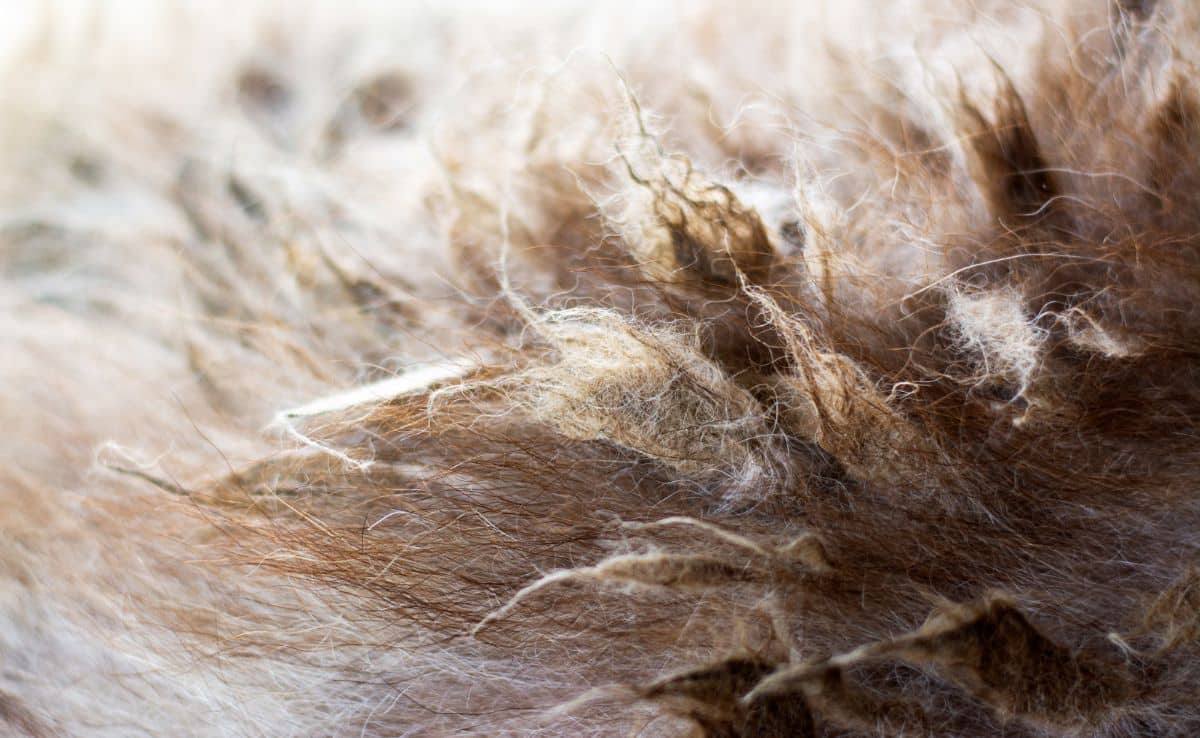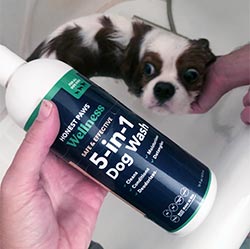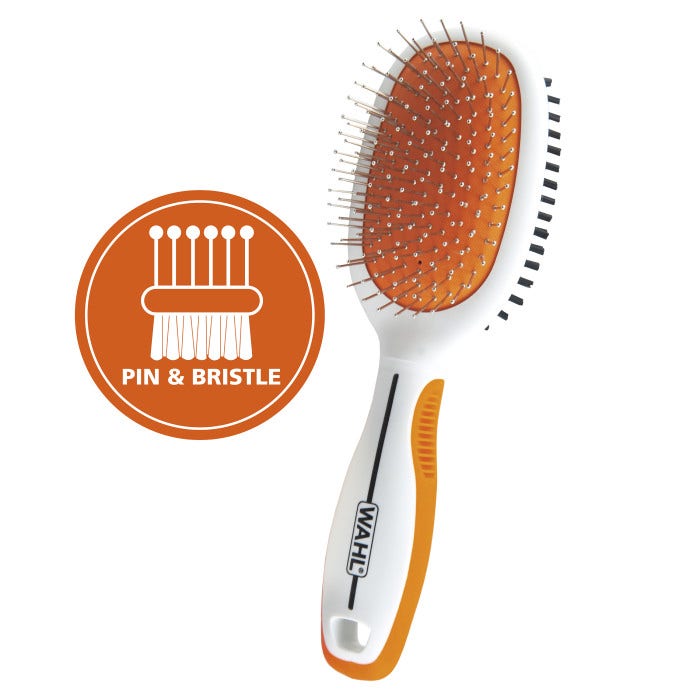What Causes Matted Hair In Dogs?
“Matting” is dense or tangled clumps of hair in a pet’s coat. Mats are more prevalent in long-haired dogs (and cats), especially during shedding season. The extra fur needs to be adequately extracted via a brush, or else matting will occur. Mats can also result from dogs scratching themselves and getting their fur wet in rain or snow.
Mats usually start with a small knot, but this can quickly turn into a large clump. Left untreated, mats get larger and more difficult to remove. Sometimes, eliminating large mats involves pulling on the skin, which is extremely painful for your pup. That’s why it’s important to understand the best way to remove them. You should seek a professional’s assistance if the mats get unmanageable.
In addition, severe matting can lead to health problems, such as poor ventilation and blood flow. If mats start to turn pink or red (or smell), you should contact your vet right away — this could be a sign of infection, which requires expert removal and treatment.

Mats can form anywhere on a dog or cat’s coat but especially where their hair is extra long: the backs of their ears, butts, tummy area, and under the arms and legs.
Maintaining a healthy coat can prevent mats from forming, so removing excessive hair through regular brushing and grooming is critical. But often, they sneak up on you out of nowhere.
Before we dive into how to demat a dog, you’ll first want to make sure you have all the right tools and products handy. These will help set you up for dematting success. After the product reviews, we share some tips on how to get knots out of dog hair.
If your dog is prone to tangles, we recommend a shampoo that both cleans and conditions. Honest Paws (a top producer of dog CBD oils) has developed a 5-in-1 Dog Wash that does just that (and more). They make their plant-based formula in the USA with coconut, palm, oatmeal, and aloe extracts. It washes, conditions, deodorizes, moisturizes, and detangles. We got the opportunity to try it out in exchange for an honest review.

While reshedding dog brushes work great for general maintenance and excess fur removal, you’ll need a specific detangler brush to remove mats as painlessly as possible. But what’s the best brush for matted dog hair? We recommend the Poodle Pet Dematting Fur Rake (or something similar) that has serrated stainless steel blades to help break up the hair while combing.
In addition to a brush and dematting comb, it’s a good idea to have a gentle comb like this stainless steel one by Hbuir to smooth out the hair. It has a comfortable handle and comes in three sizes, including a double-sided option.
Next in your arsenal is a detangling conditioning spray. While there are many products on the market, including the highly recommended Cowboy Magic spray, our top pick for the best dog detangler is SKOUT’S HONOR Probiotic Daily-Use Spray. I personally used this on our dog (in the lavender scent for a calming effect) and love that it’s an all-natural, non-GMO, tear-free treatment that stands behind a 100% guarantee (and also gives back to dogs in need).
Large Dog Slicker Brush for Debris Removal

Causes of Matted Hair in Dogs
Mats often occur in areas of friction, such as under the collar, behind the ears, in the armpits, or on the lower legs where the legs rub together or where the dog comes into contact with grass.
Dogs that sit a lot, or are “right-hipped” or “left-hipped” when they sit, will get mats from the fur being compacted in that spot, Verplank adds.
Neglect and lack of grooming also cause tangles and knots.
The MOST Matted DOG EVER | Came Off In ONE PIECE
How lovely is it to have a cute, fluffy dog? This long-coated fluffy look, has been one of the driving forces into the soaring popularity of the doodle variety. The truth is though, whilst looking utterly gorgeous when all brushed and fluffed up, these coats are hugely demanding and require very regular, professional grooming and daily maintenance at home.
From poodles and doodles to golden retrievers and cocker spaniels, any long-haired dog that lives an active, fun dog life is bound to get knots. They’re inevitable, especially as they form around collars and harnesses and any movable joint, where the hair is ‘rubbing” together. And while knots aren’t dangerous in themselves, if you don’t take proper care of your dog’s grooming, they’ll soon turn into matts.
A knot is tangled dog fur that has wrapped around itself, forming a tight ball of loose dead and live fur. When these knots are not brushed out, they will just keep growing, trapping more fur and winding tighter to the dog’s skin. This is a matt, AKA a tangled mess of knots.
While also not doing much for your pooch’s street cred, a matt can be dangerous for your dog the more time it’s left to develop. It can quickly turn into a pelt – a matt of fur, tight against your dog’s skin that can restrict airflow, create bacterial infections and even cut off circulation.
To avoid knots, matts and pelts is relatively easy though, so no need to get in a twist about it!
Knots and tangles can be easily removed using the right products and equipment, such as a good conditioner and detangling spray and a brush and comb and can often be done without the aid of a professional groomer. However, once matted, all the combing and brushing in the world will not successfully remove these matts and your dog will not tolerate how uncomfortable and sometimes painful this can be. The only way for matts to be safely removed, is to use clippers to clip beneath the problem area to free them from the skin. Depending how tight they are to the skin will determine how short a blade is required for successful removal. One removed, this relieves the tension to the skin.
Sometimes, it is just odd, small areas on the dog’s body that will be missed when brushing and combing. The most common areas these matts occur are, behind the ears (more so, if the dog scratches their ears a lot), armpits, front of chest (often caused by wearing harnesses), insides of legs and the base of the tail. Sometimes, it can be far larger areas or even the whole dog! On a thicker coat, it is quite common for owners to miss brushing right from the skin and getting the undercoat and rather just brushing over the surface of the coat. It is this soft, downy undercoat that is prone to matting. Owners can be quite surprised to hear that there is matting when they feel they brush them every day. This may be the case, but in high demanding coats, such as a double wool coat (poodle mix breeds), it is vital you have the right equipment and are using the correct technique. A comb is the most useful tool to reach that downy undercoat and pick up the fine fluff. Please don’t hesitate to ask your groomer for advice, they would happily demonstrate brushing technique to be used at home to help prevent matting.
If your dog’s matting is too far along or covering large areas of your dog, then much like
shearing a sheep, a professional groomer will recommend a close, even cut all over. Firstly, this ensures that the coat all grows back at the same time at an even rate; a fresh start! Secondly, it stops people thinking your dog has had an argument with a hedge trimmer! Whilst it may be shorter than you would like, it certainly looks smarter than having bits chopped out here and there. How short they do this will very much depend on the condition of the fur and how tight it is wound against your dog’s skin.
If the condition is very poor, your groomer may well recommend that in the dog’s best interests you check in with your vet to see if a mild sedation can be given so your dog doesn’t find the experience painful.
Naturally, a “shave-off” is going to make your dog look different and you may not like the way your dog looks. Please make peace with the fact that, A. your dog does not care what they look like, they just want to feel comfortable and live their best life! B. The coat grows back very quickly; in 6-8 weeks they will likely be back at the length you consider cute and fluffy. C. To be matt free is 100% in your dog’s best interests and meets their welfare needs.
You may be very reluctant to attend another grooming appointment for a while, however if you are wanting to grow your dog’s coat back in and have a beautiful teddy trim, it is highly advised you attend, even if it’s just for a maintenance groom, where we would bath, brush through, tidy up any lose ends and help you keep on top of the coat and prevent the matting occurring once again.
Having a matted, unkempt coat is having a negative impact on your dog’s welfare. Aside from feeling incredibly uncomfortable, it will be having detrimental effects on their overall health. Furthermore, as explained previously, they will require a close shave. This process also carries risks. Whilst every groomer will carry out their work in a careful, gentle manner and to cause no harm, when removing matting, skin irritation can unfortunately be inevitable. When removing matts, a short blade, close to the skin is used. This can have secondary effects, such as skin irritation, caused by clipper rash or after a matt has been removed, the true consequences of matting are revealed. In most circumstances, any skin irritation settles on its own and there is no need for any further intervention. However, on occasion, and usually in more sensitive areas of the dog’s body, the dog becomes aware of a feeling of soreness and starts to lick the area. Licking, irritates the area further and may then encourage the dog to start nibbling. This nibbling then may result in a wound that becomes infected and requires veterinary attention. The process of treating a matted dog doesn’t end on leaving the salon. We have developed a dematt aftercare sheet (see picture to right
) for owners to help prevent these problems occurring. But ultimately prevention is better than cure, so work with your groomer, trust your groomer and take heed their advice to prevent your dog becoming matted in the first place!
Contrary to popular belief, there is generally only TWO reasons a groomer will shave a dog short;
We trained as groomers as we LOVE to produce beautiful trims for people’s dogs and make them look fabulous. We do not enjoy doing shave-offs, but as we always say, welfare before vanity!!